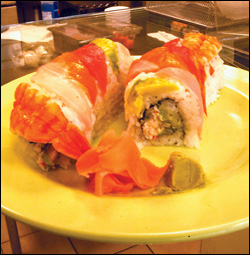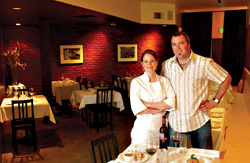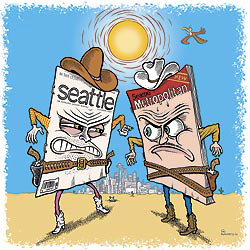Sushi may be two millennia old, and it may derive from a primitive method of preserving seafood (packing it in rice and salt kept it fresh), but lately it seems as though raw fish and wasabi have become as pervasively American as hot dogs and mustard. In fact, Judi Strata and Mineko Takane Moreno’s new primer, Sushi for Dummies, includes a recipe for “hot dog finger sushi,” while the 2002 book Judaikitsch features instructions for making “Jewshi”: gefilte-fish nuggets nestled in rice, wrapped in nori, and served with Passover-style horseradish.
Kicky fusion aside, consider the tidy eight-packs lining the refrigerated aisle of every grocery store; the ubiquity of sushi bars and classes in every major city; and Web sites like EatSushi.com, which includes a “sushi bar finder” by ZIP code, plus a sushi chat room for those looking to trade recipes and tips, or maybe just share their sushi fantasies. Speaking of which: A few local restaurants, including Bonzai Bistro in Pioneer Square, have tried to eroticize sushi by serving it on naked women, though a visit to any decent sushi bar reveals what true fans already know—the deep pink color and fleshy texture of a nice piece of toro (fatty tuna) has plenty of sex appeal all by itself.
So why would true fans spend time at Todai, the all-you-can-eat sushi buffet in Pacific Place? The obvious answer—to eat themselves silly on a food usually served in dainty little portions—would seem to violate the very spirit of sushi, the ultimate exercise in quality over quantity. (To quote Sushi for Dummies: “The best sushi includes ingredients so fresh that they’re practically still growing in the ground or swimming in the sea.”) A recent addition to the mall’s fourth-floor stable of middlebrow theme eateries, the downtown Todai is merely the latest head of a California-based corporate hydra with franchises as nearby as Redmond and as distant as Hong Kong. Next year the chain turns 20; clearly, Todai is meeting some kind of popular demand. But is this Japanese version of Old Country Buffet effectively spreading the gospel or threatening the future of sushi as we know it?
Based on two recent dinners at Todai, I would argue the latter. Between the ambience, decor, and food, the place generates a frightening synergy. During my last visit, a piped-in Spice Girls song commanded, “Tell me what you want/What you really, really want,” as I scanned the sneeze-guarded buffet; looking up, I discovered a weird, partitioned dome, like the underside of a UFO. What brought me back to Earth was the Pistons-Lakers game on several TVs, which added a sports-bar dimension to an already confused atmosphere combining elements of a college mess hall, a cruise-ship superbuffet, and the sort of “family restaurant” that awards you a free meal on your birthday (which, it turns out, is exactly the sort of restaurant Todai is).
I ventured into the buffet area with trepidation, but soon I was amassing mackerel, clam, salmon, tuna, eel, and octopus sushi like a pro. While I was at it, I made sure to pick up some crab legs, lobster claws, baked lobster, miso soup, marinated mushrooms, baby crème brûlées, yakisoba noodles, fried rice, steamed Manila clams, baked oysters, and tempura vegetables. Of these many foods, only the crab legs and soup were good; individual pieces of sushi, though lovely in appearance, were entirely unremarkable—and thus more or less interchangeable—in terms of texture and flavor. The baked lobster, soup, etc., came from the “hot foods area,” which along with the dessert table seems intended as a distraction for children—and certain adults—who fear sushi.
One major advantage of choosing Saito’s or Shiro’s or Mashiko over Todai, beyond the excitement of watching the sushi chef prepare your meal at the bar, is that each piece is made just for you, not for whoever wanders down the pike. As a business model, Todai is ingenious, as company exec Andrew Chung points out in a 2002 issue of Restaurants and Institutions. “Our international vendors deal in high volume,” Chung explains, “so we are able to get quality, fresh fish at good prices.” By culinary standards, however, it’s a failure. I don’t think leaving all that raw fish out for indefinite stretches of time is dangerous, per se, but it certainly wreaks havoc on the sushi, which is a zero-tolerance food: absolute freshness or bust. There’s no middle ground.
Spending just over $30 per adult for dinner (tax and tip included) at Todai might seem like a better value than forking over half that amount at Capitol Hill’s Aoki for a mere two spider rolls (soft-shell crab, smelt roe, and avocado), but no amount of mediocre sushi can trump the lusciousness of expertly crafted, superfresh rolls. Ideally, Todai would lead neophytes gently into better sushi experiences; the version you’ll find here, however, is unlikely to inspire passion, or even curiosity, in anyone new to the tradition. More than anything, the place brings to mind an oft-cited Woody Allen joke about two elderly women at a Catskills resort. One says, “The food here is terrible.” The other adds, “Yes, and such small portions!” Suffice it to say the second woman would have nothing to complain about at Todai.
Todai, 600 Pine St. (Pacific Place), 206-749-5100, DOWNTOWN SEATTLE. Lunch 11:30 a.m.–2:30 p.m. daily; dinner 5:30– 9 p.m. Mon.–Thurs., 5:30–9:30 p.m. Fri.–Sat., 5–9 p.m. Sun. Prices: $12.95 for lunch, $22.95 for dinner Mon.–Thurs.; $14.95 for lunch, $23.95 for dinner Fri.–Sun. Kids under 12: 5 feet and under, half-price; 4 feet and under, $5.95 for lunch, $6.95 for dinner.








